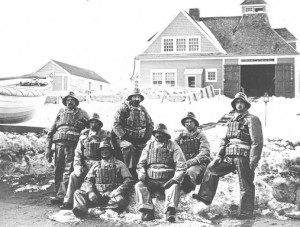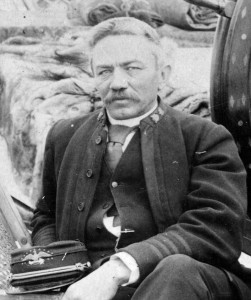Created by Congress on 4 August 1790 at the request of Alexander Hamilton the “Revenue Cutter Service,” forerunner of the contemporary United States Coast Guard, is, arguably, the second oldest branch of the United States military — after only the US Army. While the Continental Navy was formed in 1775, it was disbanded in 1785; the modern “United States Navy” was not established until 1794.
As Secretary of the Treasury, Hamilton headed the United States Revenue Service which was charged with collecting taxes. To help fulfill this important duty, Hamilton pushed for passage of the Tariff Act (1790), which authorized the construction of ten cutters, (small single-masted ships) along with the commissioning of 100 “Revenue Officers” to oversee the small flotilla.
The purpose of the early cutter force was twofold: 1) to collect customs taxes while enforcing federal law in the nation’s seaports and 2) to combat acts of piracy worldwide against US shipping. From its outset the Cutter Service performed its work well, quickly earning the respect (or hatred) of many a bootlegger, smuggler, and merchant sailor.
The additional role of “lifesaving” was established when Hamilton began issuing the order to each new master of a cutter to be “always ready” to assist mariners in distress. This charge, Semper Paratus, has since become the motto of the service.
Like today’s Coast Guard, the original Revenue Cutter Service was expected to serve a multitude of disparate missions. Its involvement in environmental protection, for example, dates to the “Timber Act” of 1822 which charged the Service with protecting government-owned forests along the western seaboard from illegal loggers.
Along with the Revenue Cutter Service, there was another agency established in the 1800s which would later be merged into the Coast Guard: the U.S. Lifesaving Service.
The USLSS began from humble upbringings in the early 1840s when the Massachusetts Humane Society founded a lifeboat station at Cohasset, MA. The station was a small wooden garage housing rescue equipment set aside for use by volunteers in case of a shipwreck near the coast. Although the idea slowly spread along the Atlantic seaboard, the earliest stations were only located near busy ports; large stretches of coastline remained without the benefit of lifesaving equipment for many years.
The Federal government became involved in coastal lifesaving in 1848 when local citizens petitioned Congress to appropriate $10,000 to establish unmanned life saving stations along the New Jersey coast south of New York. These stations were intended to provide “surf boats, rockets, carronades and other necessary apparatus for the better preservation of life and property from shipwrecks.” Soon the Massachusetts Humane Society received further funds from Congress to update and maintain their stations. During the 1850s additional stations were built by the government.

Initially uncertain as to which federal body should oversee these new properties, Congress decided to turn to the Treasury’s Revenue Service which established a new department, separate from the Cutter Service, named the “U.S. Life-Saving Service.” The stations would be staffed by local civilian fishermen expected to train with the equipment and respond in a manner similar to a volunteer fire department following a shipwreck.
The Revenue Service’s range of responsibilities expanded further during the course of the US Civil War. After the secession of southern states began in 1861, the Revenue Service began to heavily patrol near important ports and waterways.
The USRC Harriett Lane was the first ship to fire a gun in anger during the conflict. On April 12, 1861, the first day of the War, it commenced shooting at the Confederate steamboat Nashville as the latter vessel attempted to reinforce Southern troops blockading Fort Sumter. During the siege Harriett Lane was the sole communication link between the beleaguered Fort and Washington as the merchant vessel contracted for that task balked at the prospect of coming under fire.
As the Civil War unfolded the Revenue Service was given the responsibility of trying to intercept blockade runners: small, fast ships which attempted to maintain commerce between the South and Europe. These runners aimed to bring much needed currency and supplies from England and France in exchange for cotton which was in high demand across the Atlantic.
After the war, the Revenue Cutter Service and Life-Saving Services continued to perform a multitude of tasks as the nation had a continuing need for the dogged can-do spirit of the two services. For example, the Revenue Service was handed responsibility for establishing a steamship inspection department to conduct safety examinations of steamboats plying the rivers of the American heartland. The Steamboat Inspection Service, as it came to be known, was founded in 1871 after a series of high profile boiler explosions and fires over the course of the previous decade. (The most notorious involved the SS Sultana, a Mississippi River steamboat that exploded on April 27, 1865 killing close to 2,000 passengers in the largest single maritime disaster in US history). The Steamboat Inspection Service was also charged with creating a list of required on-board safety items for these boats and establishing training standards for their crews. Soon, revenue offices appeared along the banks of every major river in America from Maine to Oregon.
In 1876, a “School of Instruction” was established for the Revenue Cutter Service. Originally located near New Bedford, Massachusetts, it later moved to Curtiss Bay, Maryland before settling (in 1910) in New London, Connecticut, home of the today’s US Coast Guard Academy. Interestingly, the Coast Guard Academy is the only Service Academy that does not require a permission slip from a Senator as part of the application process. Admission is based solely on merit and academic achievement. Needless to say, the cadets of the Coast Guard Academy have some of the highest GPAs of any American students.
By 1880, the government had yet again expanded the Cutter Service by establishing a professional cadre of “lifeboatmen” at many of the existing life-saving stations. Each of these stations would henceforth be headed by a veteran member, known as the “Keeper,” who had the same amount of authority and respect as a modern Warrant Officer. The Keeper at each station was provided with a small cottage (at government expense) and charged with maintaining nearby lighthouses in addition to his other duties. The lighthouses of that era were built to mark the location of dangerous shoals, sandbars, and other hazards. As the Keepers’ routine tasks amounted to a full time job, it was not uncommon for their sweethearts, wives, or teenage daughters to assume full responsibility for the day-to-day maintenance of the lighthouses.
In this manner, it could be said that the Revenue Service was the first branch of the military to officially allow women to serve. This role would later become responsibility of the “U.S. Lighthouse Service.”
Similarly, the Revenue Service was the first service branch to commission Black Americans as officers. Arguably the most famous revenue cutter of the nineteenth century was the “Bear” which patrolled the Alaskan Coast during the late 1800’s. The Bear undertook extremely difficult and diverse tasks. The craft patrolled the coast of Alaska and the Bering Sea alone, and was expected to enforce customs laws, prevent illegal fishing, save life, and protect resources and residents alike while the Captain functioned as the sole representative of the federal government for the Alaskan people along the coastline.

The Bear was commanded by Michael A. Healy (1839-1904). Born to a mixed-race mother and white Irish-immigrant father, Healy was the first person with African ancestry to be given command of a United States warship.
Each and every commissioned, warrant, and non-commissioned officer in the Coast Guard (and the Revenue Service before it), is a sworn federal agent possessing the same authority as a US Marshal. In the late 1800s, as Captain of the Bear, Healy served as the sole Federal liaison to much of the Alaskan Territory. He performed marriages, served as judge during trials, organized relief missions during time of disaster, and arranged for routine mail service both within Alaska and back to Washington. For a man with his background to exercise such authority was virtually unheard of in America.

 Saving...
Saving...
I personally find it interesting that the Coast Guard saw so many changes over a 110 years of service, before it became a real part of the Armed services.
we can see in the early years of the 1790’s the establishment of the services that were saw to be needed and the implementation of the those services. The roles that the Coast Guard has played has been a vital one for the safe of maritime law and the safety of our nation. Even today we see the Coast guard changing roles once again in Homeland security. which after reading this post I now know more about, it seems they were set up for this role since the latter part of the 1790’s.
Our nation’s needs for security and safety should rest on the shoulders of an elite group of persons no matter their sex, as long as he or she can do the job, and as we see in this piece of literature since the founding of this great nation woman have played a vital role in make us a super power of the world. I was glad to read that the Coast Guard set a high standard in education and in personal achievements.
Jason,
I appreciate the feedback. However, I just wanted to point out that the Coast Guard, and the Revenue Cutter Service before it have always been a “real part” of the armed forces. The Coast Guard was engaging in combat operations before the US Navy, Marine Corps, or Air Force even existed.
However, they are not normally part of the Department of Defense. This is primarily due to two factors:
1) that the service has always been oriented toward defense and homeland security rather than offensive operations in foreign lands.
2) many of the missions the USCG undertakes are domestic in nature and have no concurrent assignments overseas in combat zones.
I will move further into these two issues, along with an overview of combat operations the Coast Guard has been assigned, in further articles in this series.
Thanks again for reading !